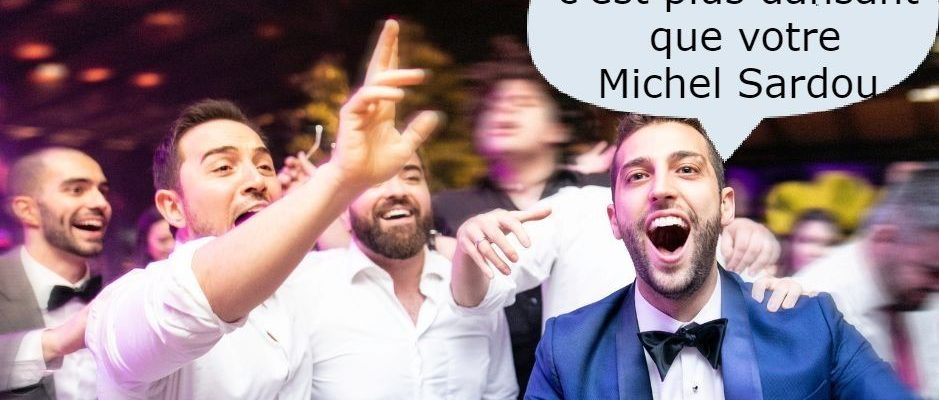For ten years, gays and lesbians can finally put the ring on their finger. The cataclysm announced by its opponents did not happen, but did the wedding dance floor revolution take place? The wedding playlists over-used by the trio of hell Start of the evening-Michel Sardou-Patrick Sébastien in a “second-degree-but-not-too much” way have they finally been decapitated on the altar of the famous and very cliché gay “good taste”?
First big disappointment on the side of the wedding agency LoL Evénements, which tells us that the wedding play-lists are the same regardless of the type of couple. Chameleon music, “which speaks to all generations, and which therefore brings everyone back to the dance floor”. The secret ? Tubes from before ninetiesbrought up to date. those nights there by Yannick, who covers Claude François, or even more recently Yanns who releases a cover of There’s sunshine and girls. “To satisfy everyone remains THE pressure of marriage”, which does not encourage too much risk-taking.
Same observation with Esteban Buch, director of studies at the Ecole des Hautes Etudes en Sciences Sociales in Paris and specialist in the relationship between music and politics: “There is no fundamental difference between what LGBT + people listen to and straight people. Even less in marriages, where the play-lists are very standardized. »
The same sounds, not the same emotions
Early end of this paper on a somewhat plan-plan moral “blabla, music is universal and touches all hearts”? Not so fast. DJ, put the sound back on, we’re off again for a round of arguments. “I don’t know if LGBT playlists are better than straight ones, but they have a bigger stake,” says Léa Lootgieter, co-author of The lesbian underwear of the song (2019, IXe edition), resuscitating the interest of this article.
“Some lyrics are going to take on a much bigger dimension for the gay and lesbian community, while straight people dance to them without paying much attention to the meaning”. This is the Mylène Farmer syndrome: music sung and danced by all sexualities, but with much more meaning and impact for homosexual people. “A lot of gay and lesbian icons have very sad lyrics, reminiscent of the oppressions suffered by the community, but very danceable. Mylène Farmer, but also Angèle and her To forget everything, Redcar, etc. and we’re not going to do the whole playlist for you.
Words sometimes “overinvested or reinterpreted, admits Léa Lootgieter, for lack of many real representations”. Because, if the icons are loved fully and the militant words shouted at the top of their lungs, they are rare, especially in a marriage. “Love songs, necessarily very present in ceremonies, rarely evoke relationships other than heterosexual. There is an invisibilization, ”recognizes Esteban Buch.
So we do with what we have, and if we don’t have, we hijack the meaning. Léa Lootgieter takes the example of Céline Dion: “The song We do not change primarily evokes the idea that one remains the same person as during childhood. But for a gay or lesbian person, words like ”We don’t change, we just put on other people’s costumes” take on a whole different meaning. »
Dancing and singing, “already a victory”
Even with few truly representative songs, don’t worry too much about the vibe on the track. Because singing and dancing “occupy an important part of this culture, as in any oppressed minority. There is an emancipatory and militant side, to dance to assume and show that we are there and that we are alive ”, develops Didier Frankfurt, historian of music.
“There is a party culture in the LGBT+ community, to reverse stigma and oppression. Less than a century ago, it was still forbidden for men to dance together”, develops Léa Lootgieter. Much more recently, “the AIDS years have been marked by dance in order to have the necessary breaths in this collective ordeal”. The slogan of the number one militant collective of the time, Act Up, was “Dance = live”.
“Dancing at a wedding is normal and classic. Dancing at a gay wedding is a victory,” summarizes Théo, who married the man of her life three years ago. “Thinking back, the music wasn’t fundamentally different from other weddings I’ve done, but it was more atmospheric. »
The same music, really?
Millennia of persecution and discrimination have inevitably left their mark. And a certain idea of music. Yes, it’s generally the same songs, but still, there are some differences. “Gay and lesbian wedding playlists need to be much less conservative. Beyond the classic Dalida disco or Brigitte Fontaine mixed with electro, no doubt the latest “in” discoveries must be present”, supposes Serge Hureau, director of the Hall de la chanson, artist and former FAHR activist (Revolutionary Homosexual Action Front) in the early 1970s.
“There are extremely festive and danceable sounds in LGBT music that play on the dichotomy between sadness and momentum of life”, repeats Léa Lootgieter. Last argument on this subject by Didier Francort: “The experience of living while being a victim of segregation gives a sensitivity open to the world and avant-garde, especially musically. »
Gala against Sardou
Finally, one of the big differences in gay and lesbian marriages compared to straight marriage unfortunately remains the absence of one or both families, “which happens much more frequently in the first case”, notes the LoL agency. event. A regrettable absence “but which puts less pressure on the choice of play-lists, and makes it possible to unleash the musical choices or to have more sexual sounds”, concludes Léa Lootgieter.
More festive, more daring, more intense and quite simply more symbolic, the LGBT+ wedding play-list therefore seems better than the straight one. The latter are not mistaken and happily dig into it, for ceremonies or any occasion to dance. Freed from Desirethe flagship anthem of the LGBT+ community, has become the unofficial sound of two of the last four major football competitions, Euro 2016 and the 2022 World Cup. Na-na-na-na-na”.

